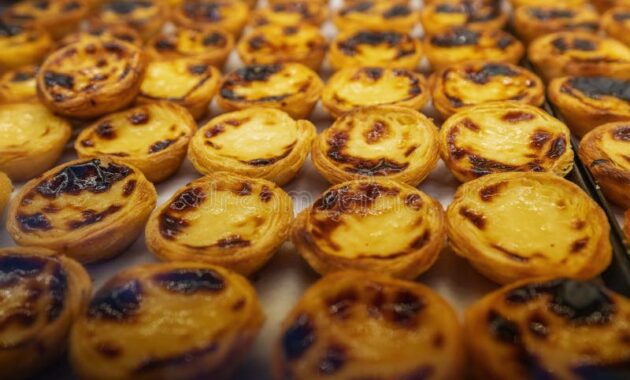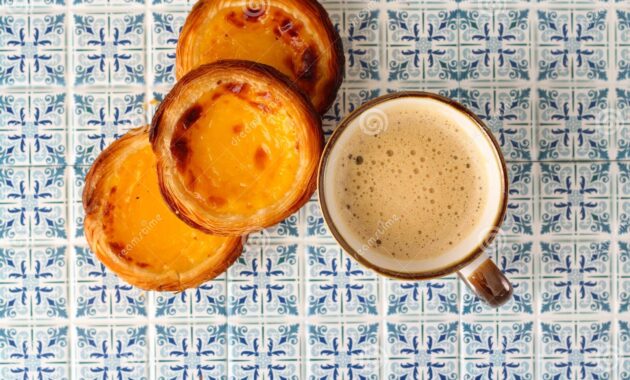Indulge in the rich, creamy perfection of authentic Portuguese Pastel de Nata custard tarts! This comprehensive guide takes you step-by-step through the process of creating these iconic treats, renowned for their flaky pastry crust and delicately sweet, eggy filling. Prepare to be amazed as you master the art of making Pastel de Nata at home, delighting yourself and your loved ones with these irresistible Portuguese pastries.

Pastel de Nata, or custard tarts, are a symbol of Portuguese culinary heritage. Their delicate balance of crispy pastry and smooth, creamy filling has captivated taste buds for centuries. This recipe ensures you achieve that perfect balance, resulting in Pastel de Nata that rival those found in the charming pastelarias of Portugal. Get ready to embark on a culinary journey that will transport you straight to the sun-drenched streets of Lisbon!

Before you begin your Pastel de Nata adventure, let’s gather all the necessary information and prepare our ingredients. This recipe is designed for those wanting to master the art of creating these delectable Portuguese treats. We’ll cover every detail, ensuring a smooth and satisfying baking experience for everyone.
| Category | Value |
|---|---|
| Preparation Time | 30 minutes |
| Cooking Time | 25-30 minutes |
| Servings | 8 Pastel de Nata |
| Difficulty | Medium |
Nutrition per serving (approximate): Calories: 250-300, Fat: 15-20g, Carbohydrates: 25-30g, Protein: 4-5g. Nutritional values may vary slightly depending on the specific ingredients used.

| Ingredient | Quantity |
|---|---|
| For the Pastry Dough: | |
| Plain Flour | 250g |
| Unsalted Butter (cold and cubed) | 125g |
| Water | 125ml |
| Pinch of Salt | |
| For the Custard Filling: | |
| Full-fat Milk | 500ml |
| Caster Sugar | 100g |
| Cornflour | 40g |
| Large Eggs | 4 |
| Egg Yolks | 2 |
| Vanilla Extract | 1 tsp |
Cooking Instructions
- Make the Pastry Dough: In a large bowl, combine the flour and salt. Cut in the cold cubed butter using a pastry blender or your fingertips until the mixture resembles breadcrumbs. Gradually add the water, mixing until a dough forms. Wrap the dough in cling film and chill in the refrigerator for at least 30 minutes.
- Prepare the Custard Filling: In a saucepan, whisk together the milk, sugar, and cornflour until smooth. Heat over medium heat, stirring constantly, until the mixture thickens. Remove from heat.
- Combine Egg Yolks and Vanilla: In a separate bowl, whisk together the eggs, egg yolks, and vanilla extract.
- Temper the Egg Mixture: Gradually whisk a small amount of the hot milk mixture into the egg mixture to temper it, preventing the eggs from curdling. Then, pour the tempered egg mixture into the remaining milk mixture, whisking constantly.
- Return to Heat: Return the mixture to low heat, stirring constantly until it thickens further into a smooth, creamy custard. Remove from heat and set aside to cool slightly.
- Roll and Shape the Pastry: On a lightly floured surface, roll out the chilled pastry dough thinly. Use a 10cm cookie cutter or a small bowl to cut out circles and press into individual tart tins.
- Fill the Tart Shells: Fill each pastry shell generously with the cooled custard filling.
- Bake the Pastel de Nata: Bake in a preheated oven at 220°C (200°C fan/Gas Mark 7) for 15-20 minutes, or until the pastry is golden brown and the custard is set. The top should have a slight caramelisation.
- Cool and Serve: Let the Pastel de Nata cool slightly before carefully removing them from the tart tins. Serve warm or at room temperature, optionally dusted with icing sugar.
Serving Suggestions: These exquisite Pastel de Nata are delightful on their own, but you can elevate the experience. Serve them warm with a dusting of cinnamon or a sprinkle of icing sugar for added sweetness. A dollop of whipped cream or a scoop of vanilla ice cream complements the creamy custard perfectly, making for a luxurious treat. You can also serve them with a strong coffee or Portuguese Vinho Verde, creating a classic Portuguese café experience.

Notes and Tips for Perfect Pastel de Nata:

- Use good quality ingredients for the best results. Full-fat milk is key to achieving a rich and creamy custard.
- Ensure the butter is very cold when making the pastry. This helps create a flaky and tender crust.
- Chill the pastry dough thoroughly before rolling it out. This prevents it from shrinking during baking.
- Don’t overfill the tart shells; leave a little space for the custard to rise during baking.
- Keep a close eye on the Pastel de Nata while baking to avoid burning. Baking times may vary slightly depending on your oven.
- For an even richer flavor, you can add a teaspoon of lemon zest to the custard filling.
- If you don’t have tart tins, you can use muffin tins. Adjust baking time as needed.
With this detailed recipe, you are well on your way to mastering the art of making authentic Portuguese Pastel de Nata. These delightful custard tarts are guaranteed to impress your family and friends, leaving them craving more of your homemade Portuguese delights. Enjoy the process and the incredible taste of your freshly baked Pastel de Nata!









